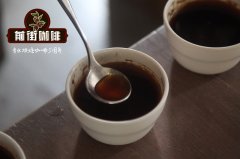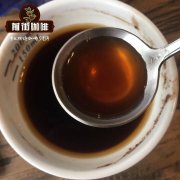How to flush cat shit coffee powder? How much is a Kopi Luwak? How did Kopi Luwak find out?

Professional coffee knowledge exchange more coffee bean information please follow the coffee workshop (Wechat official account cafe_style)
Captive civets sometimes only eat coffee fruits, but they also eat fruits, insects and reptiles in the wild.
The most expensive coffee in the world is made from poop ──, or more precisely, coffee beans that are half-digested and then pooped after being eaten by civets. This civet coffee is not cheap, and can be as high as $80 a cup in the United States.
Coconut cats are distributed in southern India, Sri Lanka, Southeast Asia and southern China. It is a nuisance to the locals in Sri Lanka because they defecate in the ceiling and indoors, often making noise and disturbing people's dreams.
Indonesian coconut cats mainly feed on coffee beans. After completing fermentation in their stomach, they destroy proteins, produce short peptides and more free amino acids, reduce the bitterness of coffee, and then discharge feces as the main raw materials.
The civet, which lives in Southeast Asia and sub-Saharan Africa, has a long tail like a monkey, a face like a raccoon, and stripes or spots on its body, which plays an important role in the food chain. in addition to eating fruits such as coffee and mangoes, they also eat insects and small reptiles, and they are eaten by cheetahs, large snakes and crocodiles.
The Kopi Luwak trade was supposed to do no harm to these animals: coconut cats, a species of civets endemic to Asian palm civet; in Southeast Asia, invade commercial orchards in Indonesia and are often regarded as a pest by locals, so the booming Kopi Luwak industry has prompted locals to protect civets for their precious droppings. The digestive enzymes in civets change the structure of proteins in coffee beans, removing some of the sour taste and making coffee more palatable.
However, Kopi Luwak is becoming more and more popular, and Indonesia has become a tourist attraction for tourists to come into contact with wild animals, so more and more wild civets are kept in cages in coffee plantations. Part of this is to produce coffee, but also to earn civets' sightseeing money.
As the coffee beans cannot be digested, they will be excreted, and after washing and baking, they will become civet coffee. It's about 400 dollars a kilo.
Coconut cats are omnivores. Apart from eating seeds, they also eat insects, snakes, birds, amphibians and reptiles, so the feces emitted by really wild coconut cats will be mixed with all kinds of substances.
Local farmers in Indonesia catch coconut cats and feed them coffee beans to make Kopi Luwak. But it is said that there is a difference between artificially cultivated and natural ones.
What makes Kopi Luwak special is that wild civets choose carefully when they eat coffee fruit, but keeping them in a cage and feeding them casual coffee fruit doesn't produce much better products.
The output of Kopi Luwak is very small and very expensive. And the land for sale is even less. It is rare even in Indonesia of origin. Therefore, most of the Kopi Luwak sold on the market are kept artificially, and their flavor is naturally different from that of the most primitive and natural wild Kopi Luwak.
Qianjie Kopi Luwak cooking suggestion:
V60According to one minute and fifty seconds, 15 ℃ / time
Important Notice :
前街咖啡 FrontStreet Coffee has moved to new addredd:
FrontStreet Coffee Address: 315,Donghua East Road,GuangZhou
Tel:020 38364473
- Prev

How to brew Kopi Luwak? What is the method of making Kopi Luwak and Kopi Luwak?
Professional coffee knowledge exchange more coffee bean information please follow the coffee workshop (Wechat official account cafe_style) have you ever heard of Kopi Luwak (Kopi Luwak)? This coffee name, which sounds a little strange, means civet coffee in Indonesian, because it is so precious that it is known as Dream Coffee. But what kind of coffee is this? Indonesian Ko
- Next

How does Kopi Luwak taste good? How did Kopi Luwak find out? Kopi Luwak.
Professional coffee knowledge exchange more coffee bean information please follow the coffee workshop (Wechat official account cafe_style) Indonesian Kopi Luwak in Indonesian Kopi means coffee, Luwak is similar to the white nose heart (or masked palm civet) similar to the civet. Kopi Luwak translates directly, which means civet coffee. The name of coffee, which sounds wonderful, is actually in Africa.
Related
- Detailed explanation of Jadeite planting Land in Panamanian Jadeite Manor introduction to the grading system of Jadeite competitive bidding, Red bid, Green bid and Rose Summer
- Story of Coffee planting in Brenka region of Costa Rica Stonehenge Manor anaerobic heavy honey treatment of flavor mouth
- What's on the barrel of Blue Mountain Coffee beans?
- Can American coffee also pull flowers? How to use hot American style to pull out a good-looking pattern?
- Can you make a cold extract with coffee beans? What is the right proportion for cold-extracted coffee formula?
- Indonesian PWN Gold Mandrine Coffee Origin Features Flavor How to Chong? Mandolin coffee is American.
- A brief introduction to the flavor characteristics of Brazilian yellow bourbon coffee beans
- What is the effect of different water quality on the flavor of cold-extracted coffee? What kind of water is best for brewing coffee?
- Why do you think of Rose Summer whenever you mention Panamanian coffee?
- Introduction to the characteristics of authentic blue mountain coffee bean producing areas? What is the CIB Coffee Authority in Jamaica?

